Staff members were Roy Andersen (Hope Church, Lenox MA, Surveyor), Gary Byers (ABR, Administrative Director and Square Supervisor), Orna Cohen (Conservator), Yoav Farhi (Institute of Archaeology, The Hebrew University of Jerusalem, Numismatist), Louis Klauder (ABR, Pottery Registrar), Suzanne Lattimer (ABR, Square Supervisor), Michael Luddeni (ABR, Photographer), Eugene Merrill (Dallas Theological Seminary, Dallas TX, Square Supervisor), Walter Pasedag (ABR, Surveyor), Brian Peterson (Lee University, Cleveland TN, Square Supervisor), Leen Ritmeyer (Ritmeyer Archaeological Design, Architect), Sandra Souza (ABR, Objects Registrar) and Scott Stripling (Wharton County Junior College, Wharton TX, Field C Supervisor).

Khirbet el-Maqatir diggers from week 1: Left-to-right, row 1: Donald McNeeley, Suzanne Lattimer, Scott Stripling, Bryant Wood, Gary Byers, Eugene Merrill, Brian Peterson; row 2: Sandra Souza, Keri Patterson, Steven Rudd, Cheri Jakway, Lisa Madron, Cathy Kramer, Joel Kramer, Shaybob; row 3: Abigail Leavitt, Janet Merrill, Scott Patterson, Juergen Schulz, Chris Jakway, Cathy Madron, Tania Fenwick, David Lawless, Ali; back row: Richard Oehme, Wyn Laidig, Carol Laidig, Michael Luddeni, Louis Klauder, Arthur Trumbore, Timothy Riddle, Roy Andersen; front: Petra Kramer, Barry Kramer, Ethan Kokoska, Rachel Kramer. (Photo by Mike Luddeni: Click to Enlarge)
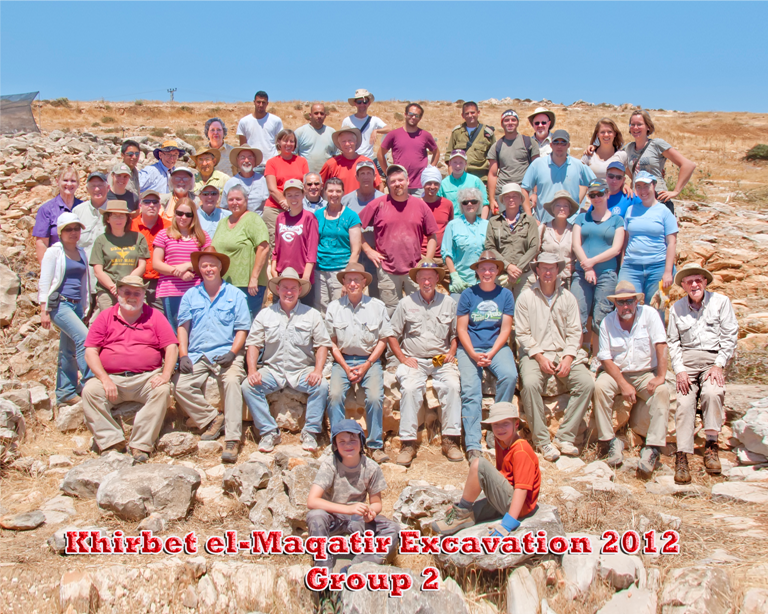
Kh. el-Maqatir diggers from week 2: Left-to-right, row 1: Donald McNeeley, Steven Rudd, Scott Stripling, Bryant Wood, Gary Byers, Suzanne Lattimer, Brian Peterson, Richard McKinney, Eugene Merrill; row 2: Jackie Maestrado, Tania Fenwick, Lisa Madron, Cathy Madron, Sarah Peil, unknown, Joel Kramer, Zynda Patton, Sandy McKinney, unknown, Rachel Loveday, Rebekah Loveday; row 3: Sandra Souza, Ralph Peil, Trevor Loveday, Cheryl Loveday; row 4: Abigail Leavitt, David McQueen, unknown, Richard Oehme, Andre Baranov; row 5: Samuel Loveday, Louis Klauder, Michael Luddeni, Walter Pasedag, Hope Loveday, unknown; row 6, Janet Merrill, Carol Laidig, Wyn Laidig, unknown, Rebekah Roberts, unknown; back row: Ali, Shaybob, Israel Ben-Ariyeh, Eyal Freiman, army officer, David Lawless, Timothy Riddle; front: Barry Kramer, Ethan Kokoska. (Photo by Mike Luddeni: Click to Enlarge)
Volunteers mainly from the US, but also from Australia, Canada, Germany and Israel participated. Eighteen squares were excavated and significant finds were made from all four occupation periods represented at the site. This was without doubt the most successful season at Kh. el-Maqatir, with the exception of the first season in 1995 when the gate of the 15th-century BC fortress was discovered.
Late Bronze I Period (ca. 1500–1400 BC)
The major focus of the dig is to elucidate the Late Bronze I fortress phase of occupation. Archaeological and geographic evidence strongly indicates that Kh. el-Maqatir should be identified as the fortress of Ai described in Joshua 7–8. 2 In Squares N7, N8, N9, O8, O9 and P9 the west wall of the fortress and a later second-century BC addition was further clarified this season. Just 33 ft (10 m) inside the western fortress wall, a 3.3 ft (1 m)-wide wide wall was traced for 36 ft (11 m) in Squares N10 and O10. The wall was part of a major structure since it continues further north and south, but its purpose remains unclear at present. In Square N17, 56 ft (17 m) south of the gate, calcined bedrock indicative of an intense fire was uncovered. The same evidence has been observed in other squares in the vicinity of the gate. Joshua 8:28 states: “Joshua burned Ai and made it a permanent heap of ruins.” Geologist David McQueen spent two days at the site examining the evidence for burning and collecting geologic samples from Square N17 and the gate area. The samples will be thermally tested to determine if they were heated to high temperatures in the past. Additional Late Bronze I pottery was found that had been “refired” as a result of being subjected to extremely high temperatures subsequent to the original kiln firing. Samples of both refired and normally-fired pottery will be thermally tested as well.

West fortification wall of the 15th-century BC fortress, with later 2nd-century BC addition, view SW (Photo by Michael Luddeni: Click to enlarge).
Architect Leen Ritmeyer spent three days at the site clarifying various architectural features, and drawing plans of the first-century house and the Byzantine church. Leen confirmed that stones beneath the first-century house east of the gate were indeed part of the Late Bronze I fortification wall as previously suspected. The line of the wall suggests that the gate had more than two chambers. Further investigation in the gate area is planned for the 2013 season.
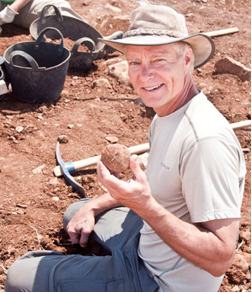
Volunteer Wyn Laidig with a newly discovered sling stone (Photo by Michael Luddeni).
One of the hallmarks of the 15th century BC fortress, in addition to a large number of storage vessels, is the presence of sling stones, the long-range artillery of antiquity. This season 18 more were added to the growing arsenal.
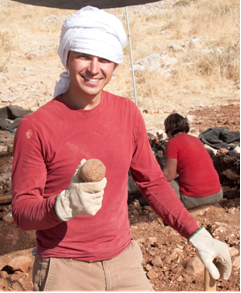
Not to be outdone, The Master’s Seminary student Andre Baranov shows off his discovery of a sling stone a few days later (Photo by Michael Luddeni).
Time of the Judges (Iron Age I, ca. 1200–1100 BC)
In the 1999 and 2000 seasons poorly-built structures from the early Iron Age I period were discovered built into the Late Bronze I fortification wall on the north side of the fortress in Squares Q9, Q11 and R11. Based on the pottery found, it appears that this occupation dates to the 12th century BC. This was the time when the Israelites were first becoming sedentary and is the period of Gideon (Judges 6–8), the migration of the Danites (Judges 17–18), Abimelech (Judges 9), Tola (Judges 10:1–2), Jair (Judges 10:3–5) and Ruth. The reason the walls were preserved in this area is that when farmers in the past encountered stones in their fields they tossed them where the ancient walls were located, since they were unable to plow in that area. Over time, the walls were covered over, thus protecting them from being robbed out for later construction.
In 1999, a stone-built storage installation in the corner of a room in Square R11 yielded a roof roller, used to compress the mud/clay and brush that the roof was composed of, a complete jug, and fragments of two additional jugs, three cooking pots and three pithoi (large storage vessels). This season a new square in this area, Q10, was opened and work was continued in Square Q11. Although living surfaces were not reached, domestic architecture from the Iron Age I period was exposed, including one wall preserved to a height of 5.5 ft (1.7 m). Significant finds in this area are anticipated in coming seasons.

Walls from the 12th-century BC in Square Q11, view west (Photo by Michel Luddeni).
First-Century AD House
Work continued in the first-century house uncovered in 2011. It was dubbed the “first-century house” because of the discovery of two first-century coins in the house: one of Porcius Festus (year 5 of Nero, AD 58/59) and one from year 2 of the First Jewish War (AD 67/68). 3 Additional first-century coins were found this season. The earliest is that of the Roman governor Ambibulus (AD 9–12) dated year 39 of Augustus (= AD 9/10). Augustus, of course, is mentioned in the New Testament as the Roman emperor who issued the census decree that caused Joseph and Mary to travel to Bethlehem where Jesus was born (Luke 2:1). Three coins from the time of Governor Valerius Gratus (AD 15–26) were recovered, dated between years 4 and 11 of Emperor Tiberius (= AD 17–24). Luke precisely dated the start of John’s ministry to “the 15th year of the reign of Tiberius Caesar—when Pontius Pilate was governor of Judea” (= AD 28/29; Luke 3:1). Next in date is a coin from the rule of the infamous Pontius Pilate from the 16th year of Tiberius (= AD 29/30), just one year after the beginning of John’s ministry and early in the ministry of Jesus.
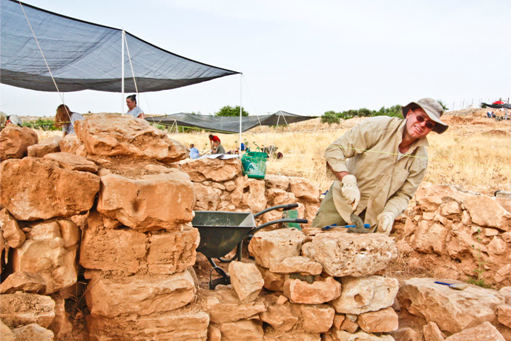
Square Supervisor Brian Peterson doing some restoration work on the first-century house (Photo by Michael Luddeni).
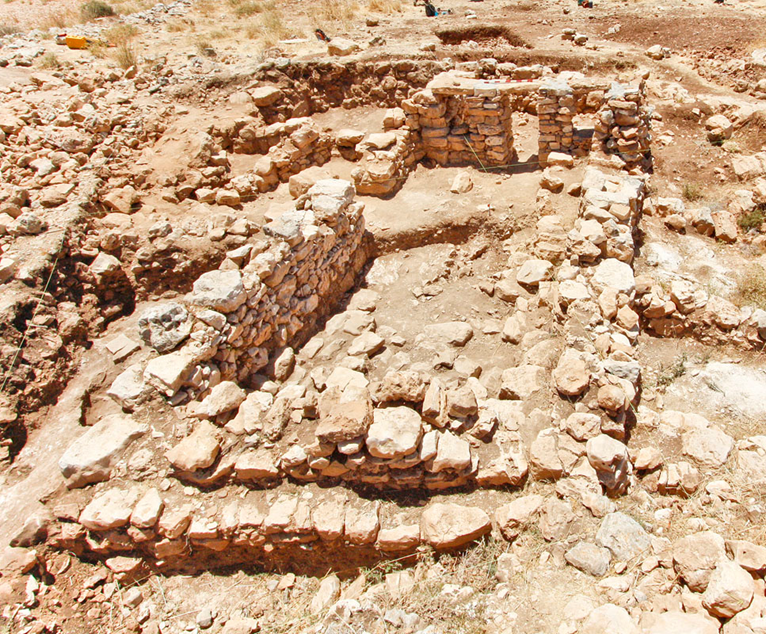
The first-century house in Squares P20, P21, Q20, Q21, with its fenestrated (windowed) wall, after Brian Peterson’s restoration work, view southwest (photo by Michael Luddeni: Click to enlarge).
Two coins from King Herod Agrippa I’s sixth year, AD 41/42, turned up. Agrippa I, called “King Herod” in the New Testament, was grandson of Herod the Great and king of Palestine from AD 37 to 44. This was early in Paul’s ministry, prior to his first missionary journey. In addition, two coins were recovered from 12–13 years later from the time of Governor Antonius Felix, dated to year 14 of Emperor Claudius (= AD 54). Claudius (AD 41–54) is mentioned in Acts 11:28 as the emperor at the time a prophet named Agabus foretold a great famine, and in Acts 18:2 where it is stated that Claudius evacuated all the Jews from Rome. Felix is the official who tried Paul in about AD 58 in Caesarea for desecrating the Temple (Acts 23:23–24:27). Two more coins of Porcius Festus were found this season, dating to year 5 of Nero (= AD 58/59). Although not named in the New Testament, Nero was the emperor Paul appealed to when he appeared before Festus at Caesarea (Acts 25–26). Finally, a second coin of year 2 of the First Jewish Revolt (= AD 67/68) was discovered. This is the latest in the series of first-century AD coins found at the site. Roman repression evidently resulted in the abandonment of the small settlement at Kh. el-Maqatir at about the time of the destruction of Jerusalem in AD 70. Occupation resumed in the late fourth century when the church was built.
Byzantine Church and Monastery (late fourth–early sixth century AD)
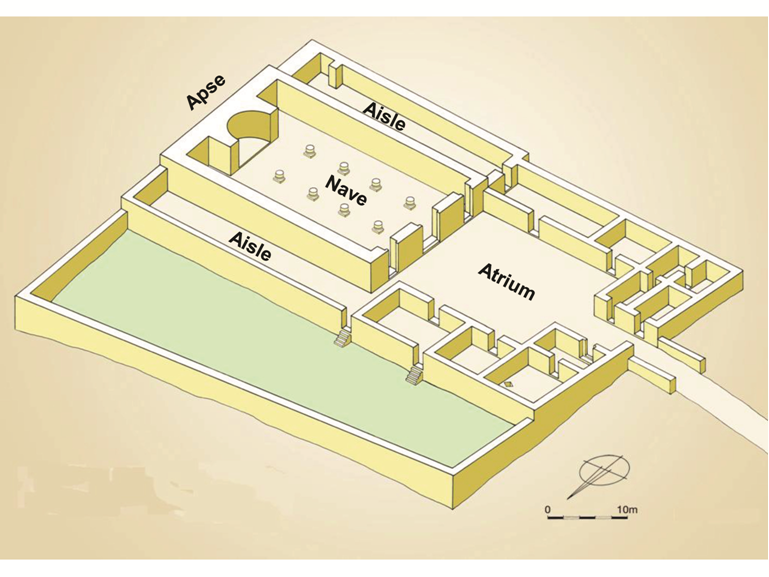
Isometric drawing of the monastery at Kh. el-Maqatir (Drawing by Leen Ritmeyer).
Exciting finds continued to be made in the Byzantine church. A third (north) apse was identified this season. Coins found in 2011 indicate that the church was founded in the late fourth century when churches were built with a single apse. It appears that sometime after the mid-fifth century, when triple apses came into vogue, the Kh. el-Maqatir church was rebuilt with three apses. A complete pillar and a number of architectural fragments were found as well. Leen Ritmeyer identified an enigmatic arched and plastered vault beneath the altar area at the front of the church as a reliquary, a place for keeping sacred objects. On the next-to-last day of excavation a complete small radiated candlestick oil lamp was discovered lying on bedrock, in the leveling fill of the church. This type of lamp was in use from the fourth to mid-sixth century.
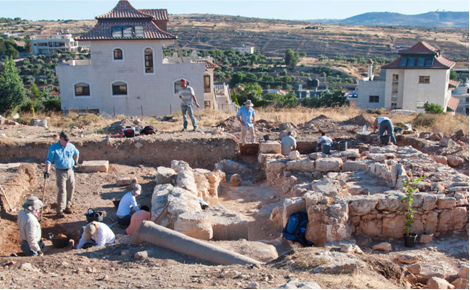
Central apse of the Byzantine church (right) and the newly discovered column (foreground), view north (Photo by Michael Luddeni).
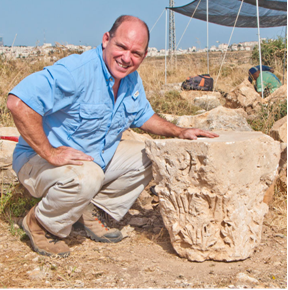
Area C Supervisor Scott Stripling with a Corinthian capital found in the church in 2011 (Photo by Michael Luddeni).
Endnotes:
1. For reports on previous seasons, see Byers 2011, 2012; Wood 1999a, 1999b, 2000a, 2000b, 2000c, 2001, 2009, 2010, 2011, 2012.
2. For a detailed study on the location of Ai, see Wood 2008.
3. For a report on coins found in 2011, see Stripling 2012.
Bibliography
Byers, Gary A.
2011 The Search for Joshua’s Ai at Khirbet el-Maqatir, 2011. ABR Newsletter 11.7.
2012 The Search for Joshua’s Ai at Khirbet el-Maqatir, 2011. Bible and Spade 25: 32–36.
Stripling, Scott S.
2012 Maqatir Monastery Money. Bible and Spade 25: 44–46.
Wood, Bryant G.
1999a Kh. el-Maqatir 1999 Dig Report. Bible and Spade 12: 109–14.
1999b The Search for Joshua's Ai: Excavations at Kh. el-Maqatir. Bible and Spade 12: 21–30.
2000a Kh. el-Maqatir 2000 Dig Report. Bible and Spade 13: 67–72.
2000b Khirbet el-Maqatir, 1995–1998. Israel Exploration Journal 50: 123–30.
2000c Khirbet el-Maqatir, 1999. Israel Exploration Journal 50: 249–54.
2001 Khirbet el-Maqatir, 2000. Israel Exploration Journal 51: 246–52.
2008 The Search for Joshua’s Ai. Pp. 205–40 in Critical Issues in Early Israelite History, eds. Richard S. Hess, Gerald A. Klingbeil and Paul J. Ray, Jr. Winona Lake IN: Eisenbrauns.
2009 The ABR Excavation at Khirbet el-Maqatir: Review of Past Work and Report on the 2009 Season. ABR Newsletter 9.7.
2010 ABR’s 2009 Excavation at Khirbet el-Maqatir: The Infant Jar Burial. ABR Newsletter 10.2.
2011 Digging up Joshua’s Ai: The 2009–2010 Seasons at Kh. el-Maqatir. Bible and Spade 224: 10–16.
2012 ABR’s 2009 Excavation at Khirbet el-Maqatir: The Infant Jar Burial. Bible and Spade 25: 37–38.